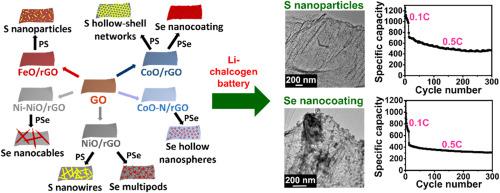Nano Energy ( IF 16.8 ) Pub Date : 2021-02-02 , DOI: 10.1016/j.nanoen.2021.105842 Ayman A. AbdelHamid , Jian Liang Cheong , Jackie Y. Ying

|
Chalcogens, especially sulfur and selenium, have wide-ranging applications, from pharmaceuticals to catalysis and energy storage. Size and morphology control are critical factors advancing the applications of sulfur and selenium. In this study, a new methodology for chalcogen nanostructure morphology control is established. The concept is based on harnessing the differential interaction of metal oxides with polysulfides and polyselenides to control the chalcogen nanostructure. Metal oxide substrates of varying compositions induce the formation of a wide range of multidimensional chalcogen morphologies, including nanoparticles and hollow nanospheres (0D), nanowires and nanocables (1D), uniform nanocoating (2D), and hollow-shell networks and multipods (3D). The chalcogen nanostructures are applied as Li-chalcogen battery cathodes. Battery testing shows direct structure-performance correlation, which favors smaller chalcogen size and shapes that allow closer contact with the substrate. Metal oxide-mediated chalcogen morphology control is a general strategy that can be applied to other fields for the advancement of chalcogen-based applications.
中文翻译:

金属氧化物介导的硫族元素差异形态发生在锂硫属元素电池中的应用
硫属元素,尤其是硫和硒,具有广泛的应用,从药物到催化和能量存储。尺寸和形态控制是促进硫和硒应用的关键因素。在这项研究中,建立了硫属元素纳米结构形态控制的新方法。该概念基于利用金属氧化物与多硫化物和多硒化物的微分相互作用来控制硫族元素纳米结构。组成不同的金属氧化物基质可诱导形成多种多维硫属元素形态,包括纳米颗粒和空心纳米球(0D),纳米线和纳米电缆(1D),均匀纳米涂层(2D),空心壳网络和多脚架(3D) 。硫属元素纳米结构用作锂硫属元素电池阴极。电池测试显示出直接的结构性能相关性,这有利于较小的硫族元素尺寸和形状,从而可以与基材更紧密地接触。金属氧化物介导的硫属元素形态控制是一种通用策略,可以应用于其他领域,以促进基于硫属元素的应用。











































 京公网安备 11010802027423号
京公网安备 11010802027423号